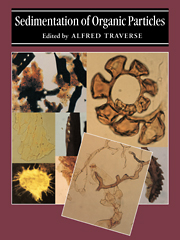Book contents
- Frontmatter
- Contents
- Editor's preface
- List of contributors
- I Introduction
- II Studies of palynosedimentation in modern environments
- III Reconstruction of late Cenozoic vegetation and sedimentary environments from palynological data
- IV Application of data on palynosedimentation to solution of geological problems
- 16 Palynology of sedimentary cycles
- 17 Particulate organic matter, maceral facies models, and applications to sequence stratigraphy
- 18 Association of palynomorphs and palynodebris with depositional environments: quantitative approaches
- 19 A quantitative approach to Triassic palynology: the Lettenkeuper of the Germanic Basin as an example
- 20 Palynomorph concentration in studies of Paleogene nonmarine depositional environments of Wyoming
- 21 Multivariate analyses of palynomorph data as a key to depositional environments of Upper Cretaceous and Paleogene coal-bearing rocks of the western United States
- 22 Relationships between depositional environments and changes in palynofloras across the K/T boundary interval
- 23 Sedimentation of palynomorphs in rocks of pre-Devonian age
- V Appendix
- Index
19 - A quantitative approach to Triassic palynology: the Lettenkeuper of the Germanic Basin as an example
Published online by Cambridge University Press: 06 January 2010
- Frontmatter
- Contents
- Editor's preface
- List of contributors
- I Introduction
- II Studies of palynosedimentation in modern environments
- III Reconstruction of late Cenozoic vegetation and sedimentary environments from palynological data
- IV Application of data on palynosedimentation to solution of geological problems
- 16 Palynology of sedimentary cycles
- 17 Particulate organic matter, maceral facies models, and applications to sequence stratigraphy
- 18 Association of palynomorphs and palynodebris with depositional environments: quantitative approaches
- 19 A quantitative approach to Triassic palynology: the Lettenkeuper of the Germanic Basin as an example
- 20 Palynomorph concentration in studies of Paleogene nonmarine depositional environments of Wyoming
- 21 Multivariate analyses of palynomorph data as a key to depositional environments of Upper Cretaceous and Paleogene coal-bearing rocks of the western United States
- 22 Relationships between depositional environments and changes in palynofloras across the K/T boundary interval
- 23 Sedimentation of palynomorphs in rocks of pre-Devonian age
- V Appendix
- Index
Summary
Introduction
The Triassic in its type area, the Germanic Basin, is characterized by a threefold lithologic subdivision: (1) the Buntsandstein, (2) the Muschelkalk, and (3) the Keuper. This facies development can be recognized in large parts of Europe, namely, Germany, Poland, Luxembourg, France, The Netherlands, the North Sea Basin and Switzerland. Muschelkalk carbonates are not represented in Great Britain. In other areas, towards the basin margins, the Muschelkalk is developed in a more clastic facies.
Although the marine standard stages of the Triassic were established in the Alpine Tethys area, the traditional lithologic units of the Germanic Basin are still often incorrectly employed as chronostratigraphic units. These lithologic units are at least partly diachronous (Kelber, 1990). The Buntsandstein and the Keuper are developed in a terrestrial facies. The marine Muschelkalk faunas are largely endemic. Hence, correlations between the Germanic and Tethyan Triassic are extremely difficult. Palynology is one of the very few methods which may enable interregional correlations of marine and nonmarine deposits.
In the last 15 years one of the major research projects of the Laboratory of Palaeobotany and Palynology (Utrecht) has focused on the palynological characterization of the Alpine Triassic standard stages and substages (e.g., Schuurman, 1976, 1977, 1979; Visscher & Krystyn, 1978; Visscher & Brugman, 1981; Van der Eem, 1983; Brugman, 1986). After palynological characterization of the marine standard stages was attempted, research concentrated on the Triassic in its classical area.
The availability of a number of continuously cored wells offered excellent opportunities for detailed palynological investigations. Studies of these well and outcrop sections in the Germanic Basin were carried out in cooperation with the Department of Geology of the Ruhr University Bochum (Germany).
- Type
- Chapter
- Information
- Sedimentation of Organic Particles , pp. 409 - 430Publisher: Cambridge University PressPrint publication year: 1994
- 16
- Cited by



